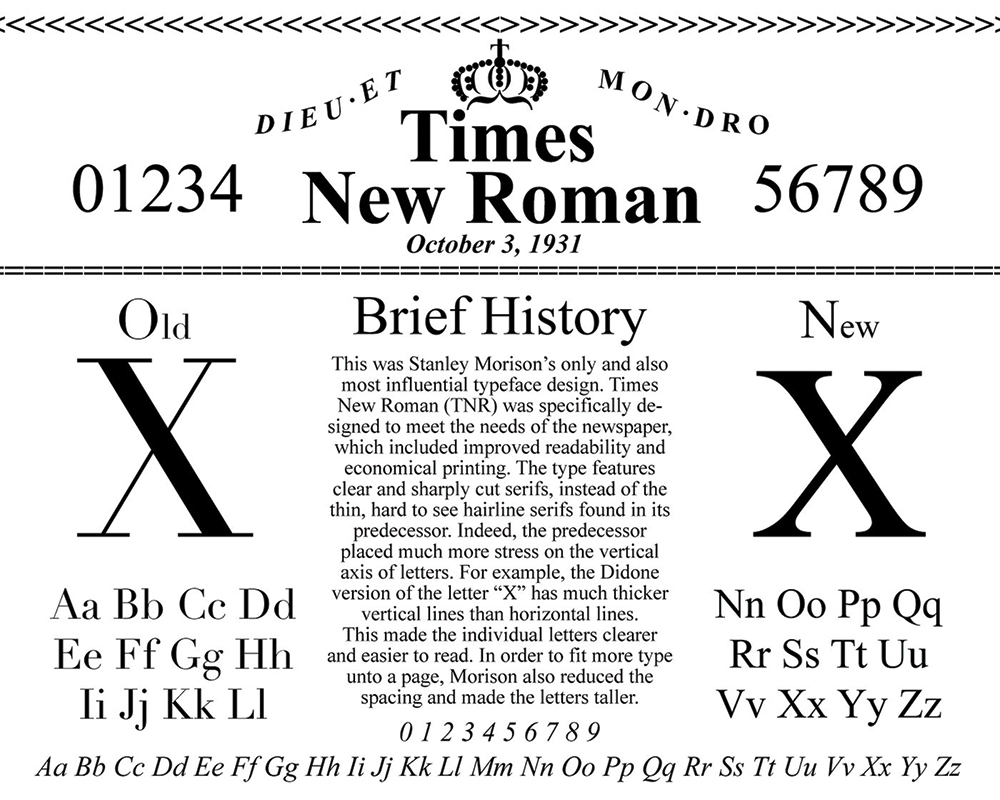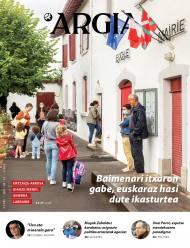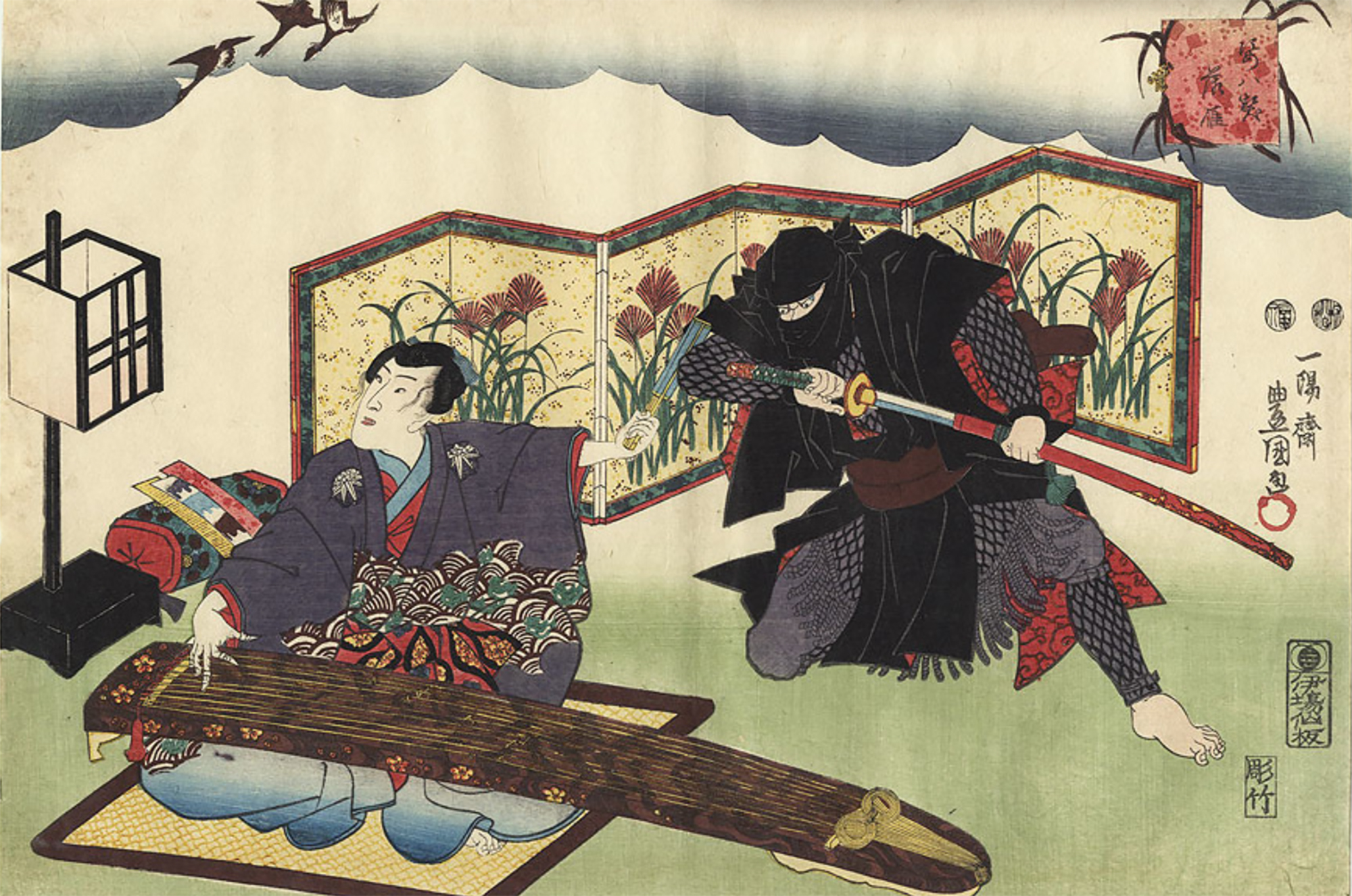Font power and typography of power
- London, 1931. On behalf of the newspaper The Times, Stanley Morison created a typography that would allow many letters to be inserted into narrow columns and, at the same time, facilitate readers' understanding: Times New Roman. This type of letter was rapidly disseminated in the press, in books and later in digital media, although nowadays this newspaper uses another type.

The typography was called Times New Roman. “Times,” of course, because it was the newspaper’s name. “New”, due to its novelty and the rejection of the Gothic typographies previously used in the press. And “Román,” because it was influenced by the Roman quadrat, or otherwise, because it was serious. These capital letters had on their edges a kind of ornaments called serifas, so that the quadrat used to give the Emperors' rules to citizens carved in stone would represent the power of the Empire for the typographers of modern and contemporary Europe. In fact, although serifas arose for a practical reason. This technique was used in many ancient scriptures, as the chiselling of texts in stone greatly hindered the clean and correct finishing of the letters.
In this sense, Times New Roman was not so new, since since the eighteenth century in the main European countries typefaces with serifas predominate. Coinciding with the flowering of nationalism, each country had its own type of letter. In Italy the letter invented by Giambattista Bodoni (1740-1813) was mainly used, while in France the invention invented by the engraver Claude Garamond (1490-1561) in the 16th century was used in England the invented by John Baskerville (1706-1775).
Each country claimed that the type of font chosen was best suited to its language, but these three examples are perfectly suited to the other languages, as Bodoni and Garamond are still among the most widely used in any of the languages that today use the Latin alphabet.
But to invent Times New Roman, another typography was spreading in London, clean, sans serif or without serifas. Its name is Underground, as it began to be used in the London Metro signals at the end of the 19th century. In Germany, the Bauhaus movement also opted for the letters without serifas, but when Adolf Hitler closed the Bauhaus school, he also rejected the typography and opted for the ancient Gothic typography Fraktur.
After the end of World War II, it was carried out by Fraktur and gained neutrality. In 1955, the Swiss created a universal typography without serifas that would spread all over the world. But just in case the letter came up when choosing the name they wanted to make clear: Helvetica.
Bilbo, 1954. Hiriko Alfer eta Gaizkileen Auzitegia homosexualen aurka jazartzen hasi zen, erregimen frankistak izen bereko legea (Ley de Vagos y Maleantes, 1933) espresuki horretarako egokitu ondoren. Frankismoak homosexualen aurka egiten zuen lehenago ere, eta 1970ean legea... [+]
Japonia, XV. mendea. Espioitzan eta hilketa ezkutuetan espezializatutako eliteko talde militarra sortu zen. Edo horixe uste du behintzat Stephen Turnbull historialari britainiarrak. Beste aditu batzuen ustez, askoz lehenago sortu ziren ninjak, duela 2.300-2.500 urte inguru. Eta... [+]
Eskultura grekoerromatarrek bere garaian zuten itxurak ez du zerikusirik gaurkoarekin. Erabilitako materiala ez zuten bistan uzten. Orain badakigu kolore biziz margotzen zituztela eta jantziak eta apaingarriak ere eransten zizkietela. Bada, Cecilie Brøns Harvard... [+]
Chão de Lamas-eko zilarrezko objektu sorta 1913an topatu zuten Coimbran (Portugal). Objektu horien artean zeltiar jatorriko zilarrezko bi ilargi zeuden. Bi ilargiak apaingarri hutsak zirela uste izan dute orain arte. Baina, berriki, adituek ilargietan egin zituzten motibo... [+]
Hertfordshire (Ingalaterra), 1543. Henrike VIII.a erregearen eta Ana Bolenaren alaba Elisabet hil omen zen Hatfield jauregian, 10 urte besterik ez zituela, sukarrak jota hainbat aste eman ondoren. Kat Ashley eta Thomas Parry zaintzaileek, izututa, irtenbide bitxia topatu omen... [+]
Luxorren, Erregeen Haranetik gertu, hilobi garrantzitsu baten sarrera eta pasabide nagusia aurkitu zituzten 2022an. Orain, alabastrozko objektu batean Tutmosis II.aren kartutxoa topatu dute (irudian). Horrek esan nahi du hilobi hori XVIII. dinastiako faraoiarena... [+]
AEB, 1900eko azaroaren 6a. William McKinley (1843-1901) bigarrenez aukeratu zuten AEBetako presidente. Berriki, Donald Trump ere bigarrenez presidente aukeratu ondoren, McKinleyrekiko miresmen garbia agertu du.
Horregatik, AEBetako mendirik altuenari ofizialki berriro... [+]
Urruña, 1750eko martxoaren 1a. Herriko hainbat emakumek kaleak hartu zituzten Frantziako Gobernuak ezarritako tabakoaren gaineko zergaren aurka protesta egiteko. Gobernuak matxinada itzaltzeko armada bidaltzea erabaki zuen, zehazki, Arloneko destakamentu bat. Militarrek... [+]
In the Maszycka cave in Poland, remains of 18,000 years ago were found at the end of the 19th century. But recently, human bones have been studied using new technologies and found clear signs of cannibalism.
This is not the first time that a study has reached this conclusion,... [+]
Porzheim, Germany, February 23, 1945. About eight o’clock in the evening, Allied planes began bombing the city with incendiary bombs. The attack caused a terrible massacre in a short time. But what happened in Pforzheim was overshadowed by the Allied bombing of Dresden a few... [+]
Judea, 2nd century AD. In the turbulent atmosphere of the Roman province, a trial was held against Gaddaliah and Saul, accused of fraud and tax evasion. The trial was reported on a 133-line paper in Greek (pictured). Thinking that it was a Nabataean document, the papyrus was... [+]
Poloniar ikerlari talde batek Sevillako Italica aztarnategiko Txorien Etxea aztertu du, eta eraikinaren zoruko mosaikoak erromatar garaiko hegazti-bilduma xeheena dela ondorioztatu du.
Txorien etxean 33 hegazti daude mosaikoetan xehetasun handiz irudikatuta. Beste... [+]
Archaeologists have discovered more than 600 engraved stones at the Vasagård site in Denmark. According to the results of the data, dating back to 4,900 years ago, it is also known that a violent eruption of a volcano occurred in Alaska at that time. The effects of this... [+]
Vietnam, February 7, 1965. The U.S. Air Force first used napalma against the civilian population. It was not the first time that gelatinous gasoline was used. It began to be launched with bombs during World War II and, in Vietnam itself, it was used during the Indochina War in... [+]
Japan, 8th century. In the middle of the Nara Era they began to use the term furoshiki, but until the Edo Era (XVII-XIX. the 20th century) did not spread. Furoshiki is the art of collecting objects in ovens, but its etymology makes its origin clear: furo means bath and shiki... [+]

























